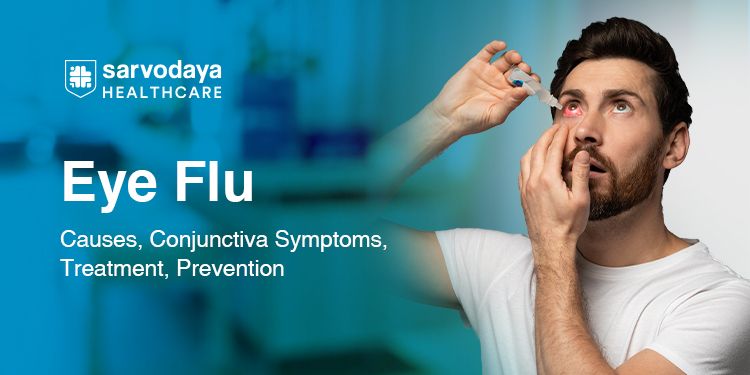In this blog, we’ll take a closer look at eye flu, how it shows up in the conjunctiva, the most effective eye flu treatment, and essential prevention tips.
What is Eye Flu?
Conjunctivitis is commonly called eye flu. In it, the conjunctiva of the eye (a thin, clear layer covering the white part of the eye and lining the inside of the eyelids) gets inflamed. When this membrane becomes inflamed, it leads to symptoms like redness, itching, and excessive tearing—what we collectively refer to as 'flu in the eyes'.Conjunctivitis can be caused by a virus, bacteria, or allergens, and the type of infection determines how it spreads and how it’s treated. Viral conjunctivitis is the most contagious form and can travel rapidly through communities, schools, and offices. Bacterial conjunctivitis, though less common, often produces thicker discharge. Allergic conjunctivitis, on the other hand, isn’t contagious but can cause persistent irritation.
Common Eye Flu Causes
Flu in eyes might sound like a seasonal virus, but it refers to various irritants or infections that inflame the conjunctiva. Let’s explore the most common eye flu causes.Some common eye flu causes are:
- Viral infections: The common eye flu reason in this virus, like adenoviruses, cause highly contagious inflammation.
- Bacterial infections: Bacteria like Staphylococcus or Streptococcus can also infect the eye, leading to pus-like discharge.
- Allergies: Pollen, pet dander, or dust mites can trigger allergic reactions, especially during seasonal changes.
- Chemical or environmental irritants: Irritants like smoke and fumes, and even chlorine in swimming pools, may inflame the eyes.
- Poor hygiene: Sharing towels, eye makeup, or contact lenses with infected individuals is a major reason for the spread.
Conjunctiva Symptoms to Watch For
The conjunctiva is a delicate membrane that plays an important role in keeping your eyes moist and protected. When inflamed due to an infection or allergy, it gives rise to symptoms commonly seen in the flu in the eyes. Recognising these signs early can prevent complications and reduce the risk of transmission.Some visible signs of flu in the eyes are:
- Redness in one or both eyes
- Itching or burning sensation
- Clear, white or yellow discharge from the eyes or watery eyes
- Crusting of eyelids, especially after sleep
- Increased sensitivity to light (photophobia)
- A grainy or gritty feeling in the eyes
- Blurred vision in severe cases
Eye Flu Treatment: What Works Best
While eye flu often resolves on its own, appropriate care can speed up recovery and reduce discomfort. To find the right eye flu treatment option, the eye flu reason must be known, whether it's viral, bacterial or allergic.Let’s go over the most effective options for eye flu treatment:
- Cold compresses: Gently applying a cold, clean cloth over the eyes can ease inflammation and reduce itching.
- Lubricating eye drops: These soothe irritation and wash away allergens or minor infections.
- Antihistamines: Use antihistamines to reduce the swelling, redness, and even the itchiness in allergic conjunctivitis.
- Avoiding contact lenses: The use of contact lenses may worsen your condition. Switch to the use of glasses until complete recovery.
- Proper hygiene: Cleaning the eyelids and avoiding contaminated items is part of supportive eye flu treatment.
- Avoiding self-medication: Using random eye drops can delay healing or cause side effects.
Preventing the Spread of Eye Flu
Eye flu is quite contagious, especially when caused by viruses or bacteria. But with simple precautions, its spread can be significantly reduced. Whether you’re recovering from the flu in your eyes or trying to protect others, prevention plays a powerful role.The most important steps in preventing the spread of eye flu are:
- Avoid sharing personal items like towels, pillows, cosmetics, or eyewear.
- Wash your hands regularly, especially if you touch your eyes or face.
- Avoid rubbing your eyes as it irritates the eye and may even spread the infection.
- Disinfect surfaces such as doorknobs, keyboards, and phones.
- Stay home from school or work until symptoms improve to avoid infecting others.
- Replace the pillowcase with a fresh one everyday during the infection.
When to See a Doctor
While mild cases of eye flu may clear up on their own, certain symptoms call for urgent medical attention. Ignoring warning signs can lead to complications like corneal damage or spreading the infection to others.Seek professional care from the best eye doctors in Faridabad, Delhi NCR, if you experience:
- Intense eye pain or swelling
- Severe redness that spreads rapidly
- Blurry vision that doesn’t improve
- Thick yellow or green discharge
- Fever or headache accompanying the eye symptoms
Timely consultation is especially crucial for children, elderly patients, and those with weak immunity. In such cases, the expertise of the best eye hospital in Faridabad, Delhi NCR, can make all the difference in ensuring a smooth, infection-free recovery.
Conclusion
Eye flu may not be life-threatening, but it should never be taken lightly. Recognising the eye flu causes, acting early, and choosing the right eye flu treatment can ensure quick relief and reduce the chances of transmission.At Sarvodaya Hospital, Faridabad, we understand how distressing the flu in eyes can be—for individuals, families, and even communities during seasonal outbreaks. Our dedicated team of ophthalmologists includes some of the best eye specialists in Greater Noida, supported by advanced diagnostic tools and infection control protocols. Whether it’s personalised eye flu treatment, allergy testing, or a preventive consultation to keep your eyes safe year-round, we are here to help.
So don’t wait until the symptoms worsen. Visit the best eye hospital in Faridabad Delhi NCR, for compassionate care, expert advice, and long-term eye health. Your vision deserves it.



















